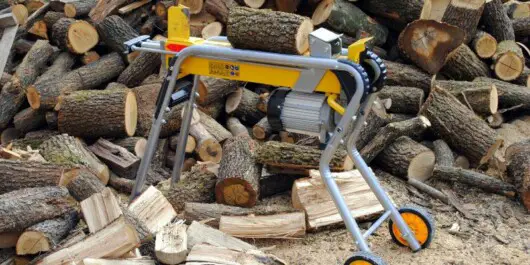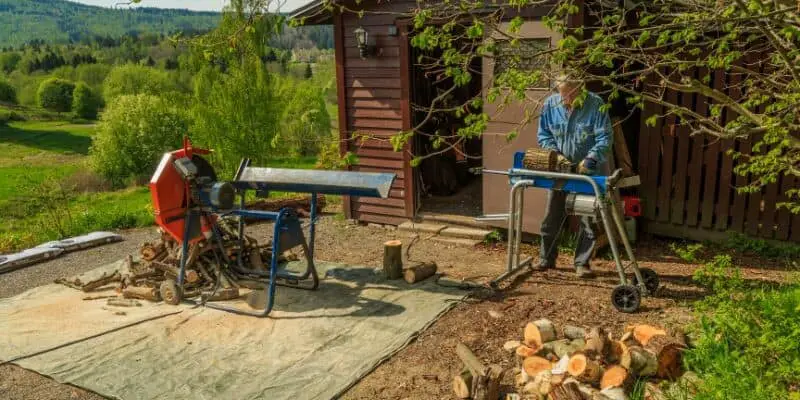Are you a log splitter user who is looking to find out the right way of storing it outside? If so, then this blog is right where you need to be.
Storing a log splitter outside is definitely possible and for as long as you want. It would be best if you store it by covering it with a tarp or something to cover the engine. Moreover, you’ll need to take the right precautionary measures. For instance, the spark plug has to be disconnected and grounded, the log splitter should be cleaned thoroughly before storing, there shouldn’t be any leftover gas or fuel, and more.
In this article, you will get to know all about storing a log splitter outside, can you store a log splitter outside, the potential drawbacks to storing a log splitter outside, and more. Continue reading to get all the answers that you are looking for.
Can you store a log splitter outside?
Wood splitters are costly and for safeguarding the investment, it’ll be best to store the log splitter in a dry place. You can always keep your log splitter nice and dry by storing it in a shed and protect your investment. However, a shed or garage isn’t always available for everyone. Sometimes, people prefer storing their log splitter outside.
In those situations, will it be harmful to leave your log splitter outdoors in the scorching sun, snow, or rain? A log splitter can surely be left outside for as long as you want. However, you need to ensure that you take the appropriate steps first.
You may be wondering can you leave your log splitter outside during the rainy season and what if it gets drenched in rain. Is there any effect on your log splitter’s performance or protection as a result? Most of the time, the answer will be yes. Rain appears to dampen the performance of your log splitter. The efficiency of your log splitter will get reduced by a few percent after water droplets fall on it.
This could be a slight dampening, but it can also be taken to mean that rain might dampen the performance of your log splitter for practical purposes. If you have been thinking of getting a log splitter, rain is something that you must factor in. As a result, the device can be deemed potentially harmful if your log splitter has gotten wet. The explanation for this is that the cover might have gotten brick or the log splitter may have been left open, leaving nothing to protect it from the rain.
Potential drawbacks of storing your log splitter outside
Condensation on the machine
When covering the log splitter when you’re storing it outside, you should make sure that you leave an opening or two. They should ideally be at the bottom so that air could come in and out when the machine is covered with the chosen material. You should keep in mind that fully sealing the machine will likely result in a slew of condensation issues.
Protection from pests
The thing about log splitters is that they will make for excellent nesting materials for a wide variety of animals. Mice, rats, squirrels, and more will inevitably find a home near your log splitter. Once they do, they will probably chew through the hose or something similar. The important thing that you need to be mindful of is that these rodents will nest there. This is inevitable, as it is in their behavior.
You should be prepared that you’re taking the needed precautions if you see them approaching. The easiest method will be to purchase a sprayer full of mint repellent and then add it to the majority of the log splitter’s surface.
Security and protection against theft
Someone can back a truck up, hook it up, and your log splitter will be gone within a matter of minutes. Leaving your log splitter in the open will expose you to the risk of getting your machine stolen. Covering the log splitter will definitely minimize the amount of attention and threat it receives. However, it is unlikely to stop a persistent thief.
How to store your log splitter outside?
If you’re looking to store your log splitter outside, the most important thing you’ll need to do is cover it. Some people use tarps, while others cover the engine with a tub or something similar.
However, it is advised that you should use a material that’s designed specifically to shield certain log splitters in this situation. That is because tarps can sometimes be difficult to put up, as you’ll need to bungee it, tie it down using wood splits, and more to keep it from blowing away. There will be no need to fiddle it with a cover, as it goes on and stays put. If you have a decent tarp that you know will withstand the elements, you can use that instead.
There are also a few precautionary steps that you should keep in mind.
First, the spark plug will have to be disconnected and grounded against the motor, as it shouldn’t restart accidentally. You should push the value lever from forward to reverse multiple times to alleviate the strain in the hydraulic system.
Then, you should be spotless the hydraulic log splitter. It’ll be important to get into the nooks and crannies, but pressure washers and garden houses need to be avoided. Water is the equivalent of kryptonite to a log splitter, as it can easily destroy the bearings and even the engine.
After that, wipe down the rig using a lightly oiled cloth while paying close attention to the wedge and beam. This will help keep the rust at bay. Once you’ve finished the cleaning, you need to move the splitter to a clean, dry place. It should also be kept away from any mold or corrosive products like acid or fertilizer. It will also be a great idea to add a rust-proof coating if you are storing it in an unventilated metal shed.
Placing wooden blocks, like a pallet, under each of the log splitter’s tires will help them last longer. Moreover, you should think of covering the log splitter’s tires to protect them from UV damage. All of that will aid in the prevention of dry rot, which can easily lead to premature tire wear. Eventually, you will need tire replacement as you’ll have to tow the log splitter around.

After using the log splitter, a lot of attention needs to be paid to the storage of your log splitter. This way, the efficiency of the log splitter can be retained for longer. Moreover, you should also make sure that you are checking the operator’s manual for more information on long-term storage.
Lastly, examine the fittings, tubes, hoses, and other parts to ensure that everything is in order. This will increase the log splitter’s durability while also for protection. You should remove any leftover fuel from the fuel tank before you store it as an extra precaution.
FAQs
Where should a log splitter be stored?
Ideally, a log splitter should be cleaned and stored in a clean, dry shed or garage.
Will the log splitter’s performance get affected if it is stored outside during the rainy season?
Yes, the water from the rain will likely harm the performance levels of the log splitter.
How to store split wood outside?
You can make use of a log rack or pallets and posts. If the firewood isn’t seasoned properly, you should stack it bark-side down such that the moisture can continue to evaporate from the wood. You’ll be able to stack the logs bark-side up once they have naturally aged to shield the wood from snow and rain.


